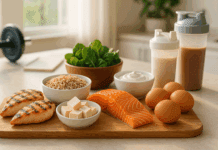Building muscle is one of the most sought-after goals for fitness enthusiasts, athletes, and anyone seeking to improve their body composition. Yet one of the most commonly misunderstood aspects of this process is caloric intake. Specifically, many ask, “how many calories should I eat to put on muscle?” The answer to this question is not a simple number—it depends on a myriad of factors, including your body type, training intensity, protein intake, metabolic rate, and recovery protocols. A high-protein diet can serve as the cornerstone of a successful muscle-building plan, but understanding the interplay between calories and protein is essential to unlocking real results.
You may also like : The Ultimate High-Protein Nutrition Plan: How to Gain Muscle in Women Safely and Effectively

Understanding the Basics of Muscle Growth and Caloric Surplus
Muscle hypertrophy, or muscle growth, occurs when the body undergoes resistance training and repairs damaged muscle fibers by fusing them together. This process requires energy in the form of calories. When you consume more calories than your body burns in a day, you are in a caloric surplus. This surplus provides the energy necessary to support anabolic (muscle-building) processes. But how many calories to gain muscle effectively? While a general guideline is to consume an extra 250 to 500 calories per day above your maintenance level, the exact number varies depending on your body size, activity level, and muscle-building goals.
If you eat too few calories, your body may lack the energy it needs to build new muscle, even if your workouts are effective and your protein intake is high. On the other hand, consuming too many calories may result in excess fat gain rather than lean muscle. Thus, fine-tuning your caloric intake to ensure a modest, controlled surplus is crucial. Incorporating a high-protein diet into this caloric framework enhances muscle protein synthesis while minimizing fat accumulation. It’s a delicate balance that requires ongoing adjustment and monitoring.
The Science Behind High-Protein Diets for Muscle Gain
Protein is the building block of muscle tissue. When you lift weights or engage in resistance training, you create tiny tears in your muscle fibers. Protein helps repair and rebuild these fibers, leading to stronger, larger muscles. But simply eating more protein isn’t enough. Your body also needs the right energy balance to put that protein to use. This brings us back to the importance of calories. You can’t just ask how many calories should I eat to gain muscle without considering protein intake in your daily diet.
High-protein diets have been shown to improve muscle mass retention during periods of caloric deficit and enhance muscle gain during bulking phases. The typical recommendation for individuals looking to build muscle is between 1.6 to 2.2 grams of protein per kilogram of body weight per day. However, for hard-training athletes or those with lower body fat percentages, protein requirements may even exceed these levels. In either case, pairing high protein intake with adequate caloric consumption ensures that the body has both the building materials and the energy needed to grow.
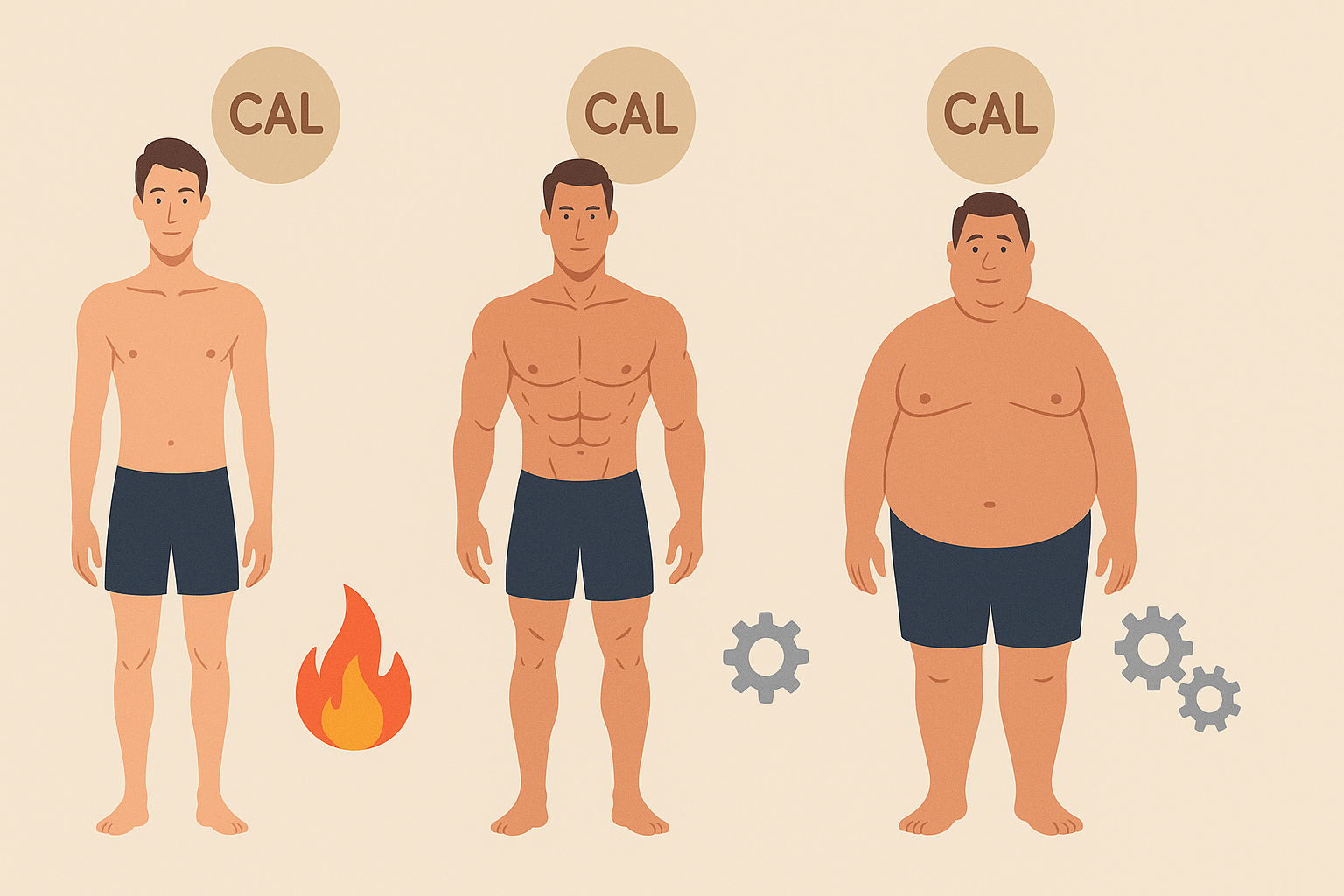
Caloric Needs Based on Body Type and Metabolism
Determining how many calories to build muscle requires a personalized approach. Ectomorphs, or naturally lean individuals, often have a fast metabolism and may need a higher caloric intake to stimulate muscle growth. In contrast, endomorphs—who naturally carry more body fat—might gain muscle more easily but are also more prone to fat gain when consuming excess calories. Mesomorphs fall somewhere in the middle and may see results with a moderate caloric surplus.
Basal metabolic rate (BMR) is another critical variable. BMR represents the number of calories your body needs to perform basic physiological functions at rest. You can estimate this using various equations, such as the Mifflin-St Jeor formula, which takes into account your age, weight, height, and gender. Once you calculate your BMR, you can multiply it by an activity factor to estimate your total daily energy expenditure (TDEE). To put on muscle, your goal should be to eat more than your TDEE consistently, ideally while tracking progress with regular weigh-ins, body composition measurements, and strength gains.
Gender-Specific Considerations for Caloric Needs and Muscle Growth
Men and women experience muscle gain differently due to variations in hormonal profiles. While men benefit from higher testosterone levels, women’s estrogen supports muscle repair and joint integrity. Female athletes may require slightly different macronutrient ratios and may benefit from more frequent meals to maintain stable energy levels and hormonal balance.
Caloric requirements for women tend to be lower due to smaller body size and lower lean muscle mass, but protein needs relative to body weight remain similar. A well-designed plan for women focuses on steady progress, hormonal health, and minimizing fat gain through controlled surpluses and structured resistance training. Understanding gender-specific physiology allows for a more tailored and effective muscle-building strategy.
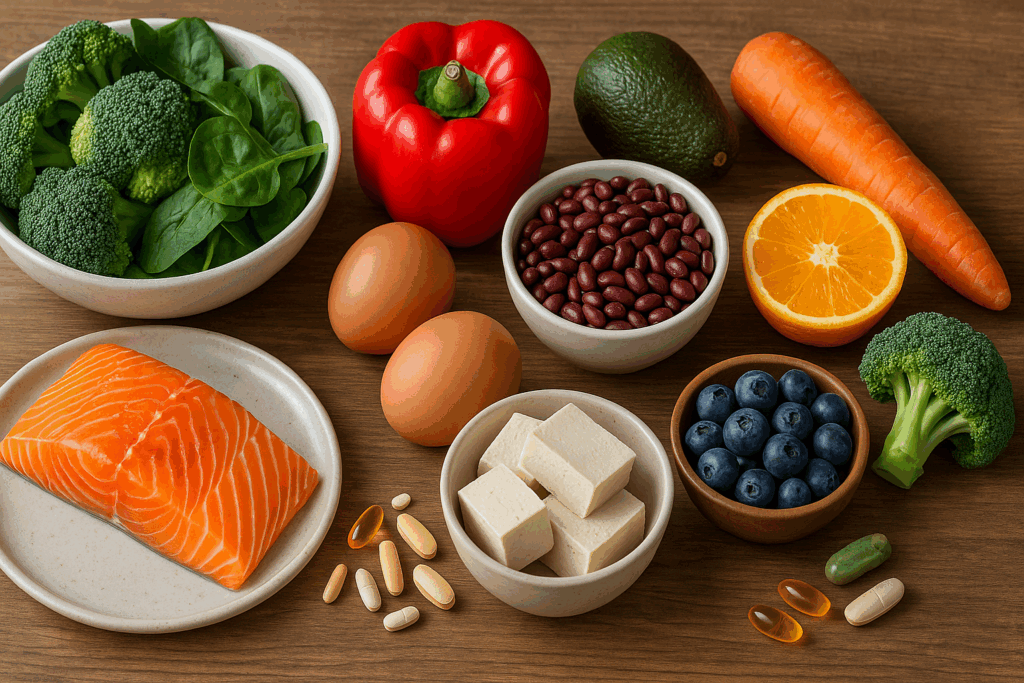
High-Protein Diets and Micronutrient Considerations
While much of the focus is on macronutrients, high-protein diets must also account for micronutrient needs. For example, increased protein intake often leads to higher phosphorus, sodium, and nitrogen loads, which may impact kidney function if underlying renal issues exist. Ensuring sufficient calcium, magnesium, potassium, and hydration can mitigate potential imbalances.
Furthermore, athletes consuming high amounts of animal protein should ensure adequate fiber intake to support digestion and cardiovascular health. Multivitamin supplementation can help cover gaps, particularly during intense training cycles. Personalized micronutrient assessments through blood testing offer insights into potential deficiencies and can further optimize your muscle-building diet.
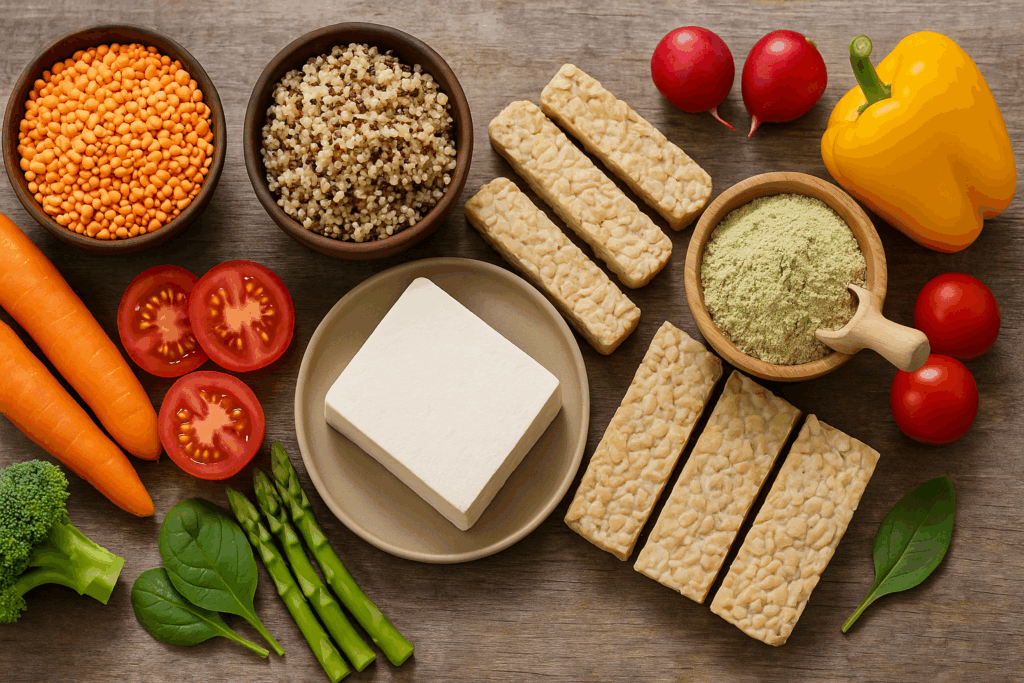
Integrating Plant-Based High-Protein Diets into Muscle-Building Plans
The rise of plant-based diets has prompted many to question whether it’s possible to gain muscle on a plant-based high-protein diet. The answer is yes—but it requires more strategic planning. Plant proteins often lack one or more essential amino acids, making it necessary to combine multiple sources to achieve a complete amino acid profile.
Examples include pairing legumes with whole grains or tofu with brown rice. Plant-based protein powders—such as those derived from pea, brown rice, and hemp—can supplement whole foods and provide high-quality protein. Additionally, plant-based diets are often rich in antioxidants, fiber, and anti-inflammatory compounds that support recovery and overall health. With careful macronutrient planning and sufficient caloric intake, plant-based athletes can build muscle effectively.
Interplay Between Sleep, Hormones, and Caloric Efficiency
Sleep is a critical yet underrated factor in muscle building and caloric efficiency. Growth hormone, testosterone, and insulin-like growth factor 1 (IGF-1) peak during deep sleep stages, facilitating muscle repair and synthesis. Sleep deprivation, on the other hand, reduces anabolic hormone levels while increasing cortisol—a catabolic hormone that can inhibit muscle growth and promote fat storage.
Ensuring 7 to 9 hours of high-quality sleep per night supports hormonal balance and improves insulin sensitivity, both of which enhance how the body utilizes surplus calories. Consistent sleep also improves workout performance, recovery rates, and appetite regulation. Individuals who struggle with sleep may consider establishing a regular sleep routine, limiting blue light exposure at night, and managing stress to enhance recovery and muscle development.
How Many Calories Should I Eat to Put on Muscle Without Excess Fat?
Achieving a lean bulk—where muscle gain is maximized while fat gain is minimized—requires precision. So how many calories should I eat to put on muscle without sacrificing body composition? A common strategy is to begin with a surplus of 10% above your TDEE. For example, if your TDEE is 2,800 calories, a 10% surplus would equate to approximately 3,080 calories per day. Monitor your weight weekly, and if you are gaining more than 0.5 to 1 pound per week, you may be in too large of a surplus.
Slow and steady is the name of the game when it comes to lean muscle building. This gradual approach allows your body to adapt and efficiently convert the surplus calories into muscle tissue. Additionally, when accompanied by a high-protein diet, the risk of fat gain is further reduced. Protein has a higher thermic effect compared to fats or carbohydrates, meaning your body uses more energy to digest it. This metabolic boost, combined with its muscle-preserving benefits, makes protein a powerful ally in body recomposition.

Meal Timing and Nutrient Distribution for Maximum Gains
When and how you eat can be just as important as how much you eat. Spacing your meals evenly throughout the day helps maintain a constant supply of amino acids in the bloodstream, promoting continuous muscle protein synthesis. For example, consuming 30 to 40 grams of protein every 3 to 4 hours can ensure your muscles remain in an anabolic state.
Pre- and post-workout nutrition also play critical roles. Consuming a protein- and carbohydrate-rich meal before your workout provides the energy needed to perform at your best. After your workout, a similar meal helps replenish glycogen stores and jumpstarts muscle repair. It’s worth noting that protein timing is especially beneficial within the two-hour window following training, as this is when muscles are most sensitive to nutrients. So while total daily intake remains the primary driver of progress, strategic nutrient timing can enhance results.
Macronutrient Ratios: More Than Just Protein
While protein takes center stage in any muscle-building diet, the roles of carbohydrates and fats should not be overlooked. Carbohydrates serve as the primary energy source for intense training, helping to fuel your workouts and support recovery. Without enough carbohydrates, you may find yourself fatigued, underperforming in the gym, and ultimately impeding your muscle growth.
Fats are also vital, especially for hormone production, including testosterone—a key hormone in muscle development. Aim for healthy fat sources like avocados, nuts, seeds, olive oil, and fatty fish. A general macronutrient breakdown for muscle gain might look like this: 40% carbohydrates, 30% protein, and 30% fat. However, these ratios should be adjusted based on personal preferences, digestive comfort, and progress tracking. The key is to maintain flexibility while ensuring all macronutrients are represented in your diet.

Tracking Progress and Making Adjustments
Once you’ve established your caloric needs and macronutrient breakdown, tracking becomes essential. Tools like food journals, calorie-tracking apps, and periodic body composition assessments can provide valuable feedback. If you’re not seeing desired changes—whether in weight, muscle definition, or strength—it may be time to revisit your intake.
Increasing your calories by another 100 to 200 per day could reignite muscle growth if you’ve hit a plateau. Alternatively, if fat gain becomes apparent, you may want to reduce your surplus slightly or increase training volume. The body is dynamic, and metabolic adaptations are normal, especially with prolonged bulking phases. Regular assessment and adjustment ensure your strategy remains effective and aligned with your goals.
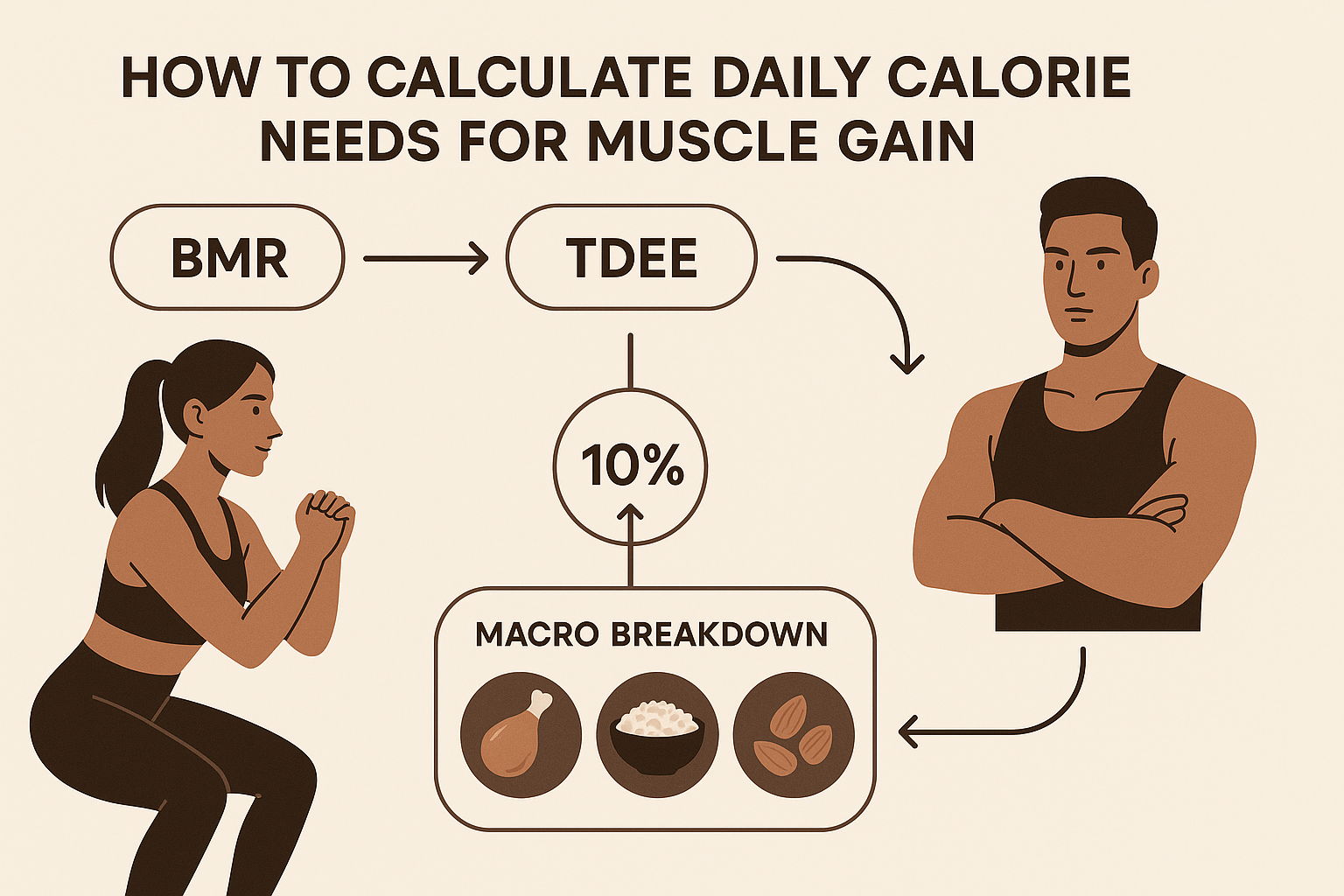
How Many Calories Should I Eat to Build Muscle on a High-Protein Diet?
Integrating high-protein strategies into a muscle-building calorie plan enhances effectiveness across the board. So how many calories should I eat to build muscle on a high-protein diet? The answer lies in tailoring your protein intake to meet your needs while ensuring enough calories are available to support muscle synthesis.
Let’s assume you weigh 170 pounds (77 kg) and aim for 2 grams of protein per kilogram of body weight. That equates to 154 grams of protein, or roughly 616 calories from protein (since protein provides 4 calories per gram). Now consider your TDEE is 2,800 calories. Adding a 10% surplus brings your total goal to 3,080 calories per day. Subtracting protein calories leaves 2,464 calories to be split between carbs and fats. Allocating these thoughtfully ensures energy is available to power workouts and support recovery.
It’s also important to choose high-quality protein sources such as lean meats, eggs, dairy, tofu, legumes, and protein powders. These sources provide complete amino acid profiles and are more effective at stimulating muscle protein synthesis than lower-quality alternatives. Ultimately, the interplay between calorie intake and protein quantity determines the success of your muscle-building journey.
How Many Calories to Gain Muscle Without Gaining Fat?
This is one of the most frequently asked questions by fitness-conscious individuals. How many calories to gain muscle without gaining fat? The key lies in precision. Instead of large caloric surpluses, opt for a modest surplus and track your progress carefully. Implementing a lean bulk strategy, combined with strength training and cardio, helps ensure that the majority of weight gained is muscle.
The role of cardio is often misunderstood in bulking. Moderate cardiovascular activity supports heart health, aids in nutrient partitioning, and helps regulate body fat levels. Incorporating 2 to 3 low- to moderate-intensity sessions per week can support your goals without hindering muscle growth. Additionally, sleep and recovery must not be overlooked. Muscle tissue grows during rest, not during workouts. Aim for 7 to 9 hours of quality sleep per night to optimize hormonal balance and muscle repair.
How Much Calories Should I Eat to Gain Muscle If I’m Overweight?
If you’re starting your muscle-building journey from an overweight state, your approach to caloric intake may differ. The goal becomes optimizing body composition rather than simply adding mass. In this scenario, you might be able to build muscle while maintaining or even reducing fat, especially if you’re new to resistance training.
Begin by estimating your TDEE and aim for a slight caloric surplus or even maintenance-level calories while prioritizing high-protein intake. This strategy, often referred to as body recomposition, allows for simultaneous fat loss and muscle gain under the right conditions. Resistance training combined with a nutrient-dense, high-protein diet can yield impressive results over time. Protein’s satiating effects also help manage appetite, which is crucial for adherence and long-term success.
Common Pitfalls to Avoid in Muscle-Building Diets
Overeating in hopes of speeding up muscle growth is a common misstep. Excessive caloric intake can lead to unwanted fat gain, which then requires cutting cycles to remove. Additionally, underestimating protein requirements or failing to distribute protein intake evenly throughout the day can limit hypertrophic adaptations.
Another frequent issue is neglecting micronutrients. Vitamins and minerals play essential roles in metabolism, muscle function, and recovery. A well-rounded diet that includes fruits, vegetables, whole grains, and healthy fats ensures that you’re not only hitting your macronutrient targets but also supporting overall health. Hydration is another overlooked factor—muscles are roughly 75% water, and dehydration can impair strength and endurance.
Frequently Asked Questions: High-Protein Diets and Caloric Needs for Muscle Gain
1. How Many Calories Should I Eat to Put on Muscle Without Gaining Excess Fat?
To put on muscle without excessive fat gain, it’s important to create a controlled caloric surplus tailored to your current metabolism, activity level, and body composition. Many people benefit from starting with a surplus of about 250 to 300 calories above maintenance, then gradually increasing as needed based on progress. Using a food diary or macro tracker allows for precise adjustments over time, especially when muscle gain plateaus. Emphasizing nutrient-dense, whole foods and monitoring your body fat percentage monthly can help fine-tune your approach. This precision is critical for those wondering how many calories should I eat to put on muscle without compromising leanness.
2. What If I’m Not Hungry Enough to Eat in a Caloric Surplus?
For some individuals, especially those with fast metabolisms or high energy demands, maintaining a caloric surplus can be challenging due to appetite limitations. In this case, energy-dense foods like nut butters, dried fruits, smoothies, and whole milk can help increase calorie intake without large food volumes. Liquid calories from protein shakes and nutrient-rich juices are also helpful. Eating more frequently, such as five to six smaller meals per day, can ease digestive strain and improve nutrient absorption. Mindful eating habits and stress reduction techniques may enhance appetite over time.
3. How Do I Know If I’m Eating Enough Calories to Gain Muscle?
Gaining muscle is not just about consuming more food—it’s about consuming enough of the right foods consistently over time. If you’re increasing strength in the gym, noticing slight weight gain each week (typically 0.25 to 0.5% of body weight), and seeing positive changes in measurements or progress photos, those are good signs you’re on the right track. If your weight is stagnant for two weeks or more, increase your intake by 100 to 200 calories per day. Pay attention to training recovery, sleep quality, and energy levels, as they are indirect indicators of sufficient caloric support for muscle synthesis.
4. How Many Calories to Gain Muscle If I Train With High Volume?
High-volume training requires greater caloric input due to the increased energy expenditure and recovery demands. Athletes engaging in extended resistance training sessions or twice-daily workouts may need to exceed the traditional 10% caloric surplus, potentially approaching 15% or more above maintenance. In these cases, timing carbohydrates around your workout—before, during, and after—can optimize glycogen replenishment and muscle recovery. Fat and protein distribution throughout the day also becomes more critical. Those performing high-volume regimens often revisit the question of how many calories to gain muscle with added urgency, as under-fueling leads to stalled progress.
5. Why Is the Focus on Protein So Critical in Muscle-Building Diets?
Protein not only provides the amino acids necessary for muscle repair and growth, but it also supports satiety, insulin regulation, and recovery processes. While caloric surplus drives overall growth, insufficient protein may redirect those surplus calories toward fat storage rather than lean mass. Additionally, the thermic effect of protein slightly increases metabolic rate, making it more efficient for lean mass development. High-protein intake becomes even more important during cutting cycles to preserve muscle. Optimal protein intake ensures that the answer to how many calories should I eat to gain muscle also includes quality nutritional choices, not just quantity.
6. How Many Calories Should I Eat to Build Muscle During a Mini Bulk?
A mini bulk typically lasts 4 to 6 weeks and focuses on rapid yet controlled muscle growth without extended fat accumulation. In such short-term surpluses, individuals may target a surplus of 300 to 500 calories, depending on their training intensity and metabolic rate. Mini bulks are often implemented following maintenance or cutting phases to jumpstart hypertrophy with renewed anabolic signaling. While the timeframe is compressed, consistency in meal timing and macronutrient balance remains crucial. When asking how many calories should I eat to build muscle efficiently in a mini bulk, precision and tracking become your greatest allies.
7. What Role Does Sleep Play in Caloric Efficiency and Muscle Growth?
Sleep profoundly affects how effectively the body uses calories to support muscle growth. During deep sleep, growth hormone secretion peaks, and this hormone is instrumental in tissue repair and muscle regeneration. Inadequate sleep raises cortisol, a catabolic hormone that inhibits muscle growth and may increase fat storage. Poor sleep also impairs appetite-regulating hormones, leading to erratic hunger and possible dietary inconsistencies. Ensuring 7 to 9 hours of quality sleep per night helps your body convert the calories you eat into functional lean mass, making the strategy behind how many calories to build muscle far more efficient.
8. Can You Build Muscle Without Tracking Calories?
It is possible to gain muscle without meticulously tracking every calorie, but it requires strong body awareness, consistent eating patterns, and experience. Visual cues such as portion sizes, hunger regulation, and physical feedback can guide intuitive eaters. However, for individuals with specific physique or performance goals, tracking at least periodically can provide clarity and eliminate guesswork. A hybrid model—where macros are estimated rather than logged daily—can strike a balance between freedom and precision. While asking how much calories should I eat to gain muscle without tracking, the focus should remain on structured meal routines and balanced macronutrient inclusion.
9. How Many Calories Should I Eat to Put on Muscle If I’m Over 40?
Age introduces changes in metabolic rate, hormone levels, and recovery capacity, which all influence muscle-building potential. Individuals over 40 may need to focus more on resistance training intensity, protein quality, and recovery protocols. Caloric needs often remain high if activity levels are maintained, but surpluses should be smaller—typically 150 to 250 calories above maintenance—to avoid fat gain. Nutrient timing and supplementation with creatine or omega-3s may enhance anabolic sensitivity in aging muscles. When determining how many calories should I eat to put on muscle later in life, precision and hormonal support become as important as caloric quantity.
10. Is There a Difference Between How Many Calories to Gain Muscle and How Many to Maintain It?
Absolutely. Once you’ve achieved your target muscle mass, the number of calories required to maintain that muscle is typically lower than the amount needed to build it. Maintenance requires enough energy to support muscle repair and basic metabolic functions but does not require the same surplus used during a bulk. However, the larger your lean mass, the higher your maintenance calorie level becomes, since muscle tissue is metabolically active. Transitioning from a surplus to maintenance should be done gradually to prevent sudden fat gain or strength loss. Understanding how many calories to gain muscle versus maintain it provides clarity in post-bulking nutrition strategies.
Conclusion: Building Muscle with Precision and Purpose
Mastering the muscle-building process requires more than just lifting heavy weights and eating indiscriminately. It demands an informed, intentional strategy grounded in nutritional science. Understanding how many calories should I eat to put on muscle is at the heart of this strategy. Whether you are wondering how many calories should I eat to gain muscle, how many calories should I eat to build muscle, or how many calories to gain muscle without fat, the answer always circles back to individualized, high-protein, calorie-controlled nutrition.
By pairing resistance training with a high-protein diet and fine-tuning your caloric intake to match your metabolism and body type, you can stimulate muscle growth safely and effectively. Each meal, workout, and hour of rest becomes a stepping stone toward your transformation. When you track progress, stay consistent, and adapt based on feedback, muscle gain becomes not only achievable but sustainable.
Ultimately, the power to build the physique you envision lies in the synergy between your diet, training, and mindset. Armed with knowledge and guided by the question “how much calories should I eat to gain muscle?”—you’re ready to sculpt a stronger, healthier, more resilient body from the inside out.




